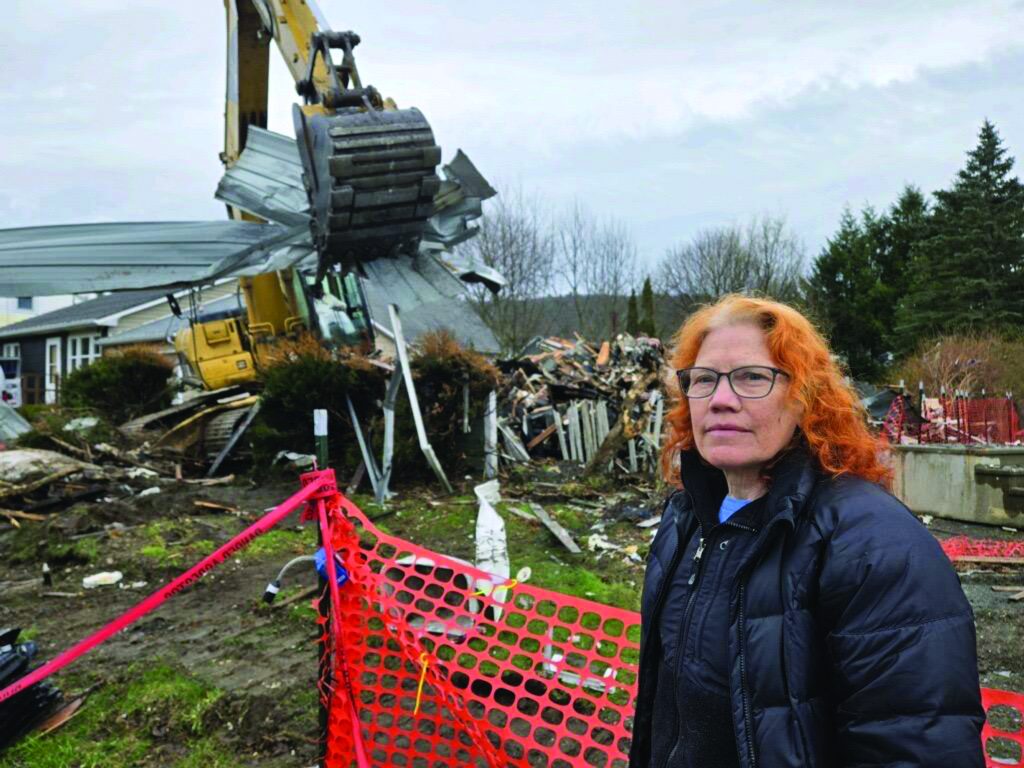
Richards Avenue Gas Explosion Not Over for Residents
By TERESA WINCHESTER and ROBERT BENSEN
ONEONTA
Barbara Doyle watched the jaws of the excavator demolishing her house. It had been fire-damaged, the entire north wall blown off, mattress and furniture spilling out of the sagging floors. She shouted as the jaws of the machine tore into the roof again and again, “You animal! You animal!” Then she paused. “This is such fun,” she said. “It should have happened a long time ago.” Gone is the house at 16 Richards Avenue built in the 1930s. Gone are the new windows Doyle had put in, the new porches, and the solar panels on the garage roof. The wreckage was hauled away, the yard filled with topsoil and leveled. It is now a vacant lot.
The March 25 demolition took place nearly four months after the December 9, 2023 gas explosion that took the life of Doyle’s next-door neighbor, Desmond Moan, who lived at 18 Richards Avenue. The explosion had blown his house to smithereens. Shockwaves were felt for miles around, the sound of it reportedly heard as far as 15 miles away. The blast shook houses throughout the entire neighborhood, rocked some off their foundations, shattered walls and windows—and the lives of multiple residents of Richards Avenue.
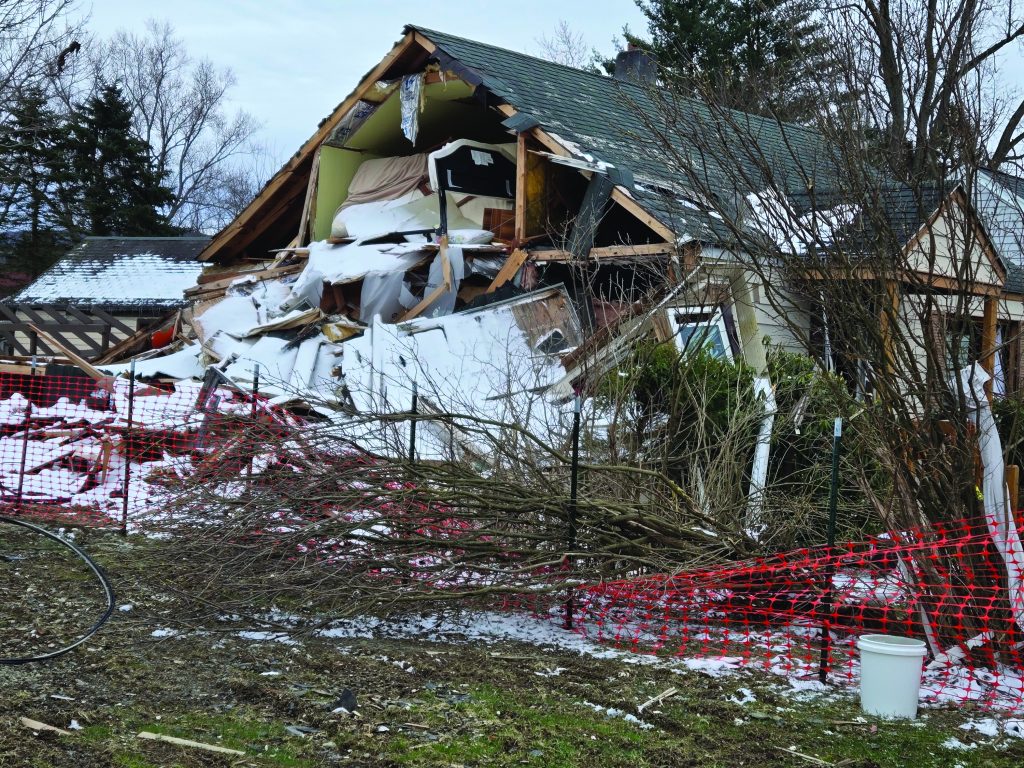
“I thought we had been hit by a bomb. There was a pile of rubble and a huge hole in the ground,” said Richard Baird, who for 12 years had been renting a room at 17 Richards Avenue.
Baird immediately called the home’s owner, Melanie Castine, who was grocery shopping at the time. She said that Baird told her to come home right away, the house across the street had blown up. She asked him two more times to repeat what he had said, unable to believe what she was hearing.
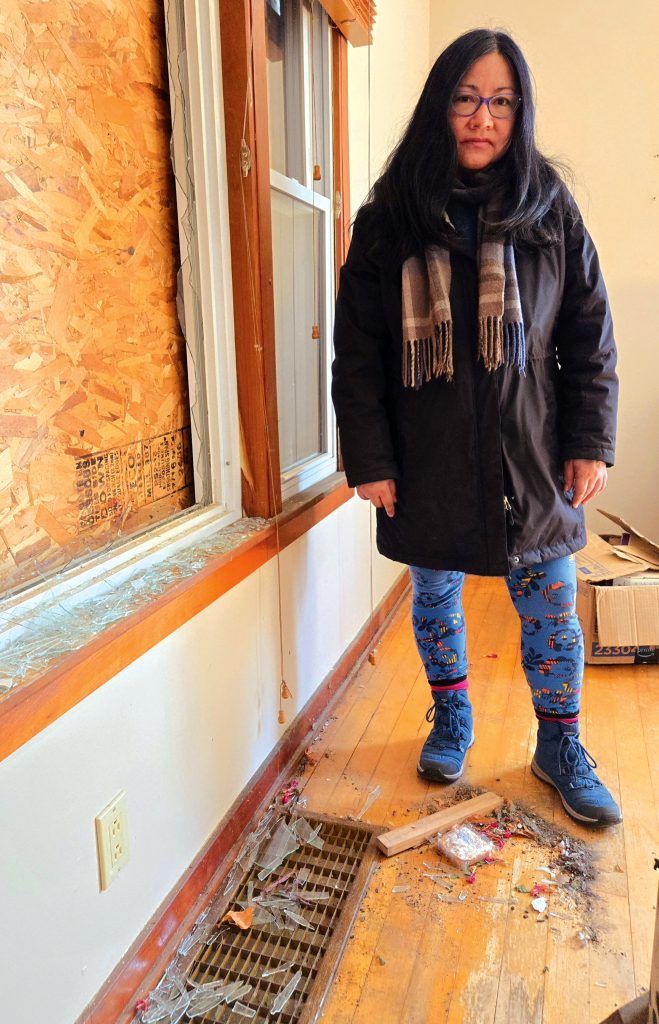
“Indeed, it had,” Castine said. “And then I realized so had mine. And so had a lot of others in the area.”
Just before the explosion, Baird was watching television in the front room, which had a large front window.
“The window exploded inward. I was thrown to the floor. The explosion lifted the entire house up. Melanie’s dog, Frodo, was thrown across the house. There was glass on top of me. I was lucky no glass went into me,” Baird said.
A Fireball Bigger Than the House
As he was getting up, Baird looked out on Moan’s house.
“It was a fireball bigger than the entire two-story house,” he said.
The adjacent house at 20 Richards Avenue, belonging to Clare Anderson, was also on fire.
“I grabbed Frodo and went to my other neighbor’s, down the street. I watched Clare’s house as it caught on fire. Clare came to join us,” Baird said.
Like Baird, Polly Bailey, living at 15 Richards Avenue with her husband, Charlie, and grandson Tyler Coffin, also thought a bomb had been dropped.
“It happened at 5:30 on the dot. We were watching the news. I had just stood up to ask about dinner. I was thrown across the room,” she said.
“Oh, my god! Putin’s dropped a bomb!” This was Bailey’s immediate impression.
“I ran outside,” she continued. “Desi’s house was gone, shattered everywhere. There was a man running down the street, screaming, ‘That’s my brother’s house. I was just talking to him on the phone.’”
First Responders Arrive
Both Baird and Bailey said that police and fire services arrived with surprising speed.
The Oneonta fire and police departments, Otsego County Office of Emergency Services, Otsego County Sheriff’s Office, New York State Police, and other local and state agencies assisted in the response. Mutual aid arrived from Laurens, Otego, Milford, Franklin, Schenevus, West Oneonta and Worcester fire departments.
Standard emergency protocols were enacted. Town of Oneonta Codes Enforcement Officer Paul Neske acted as incident commander. Residents were quickly evacuated so that emergency services could address the situation. Even after the fire had been extinguished, evacuees could not go home immediately. Many spent the night at the Hampton Inn on River Street in Oneonta. Some stayed there for several days.
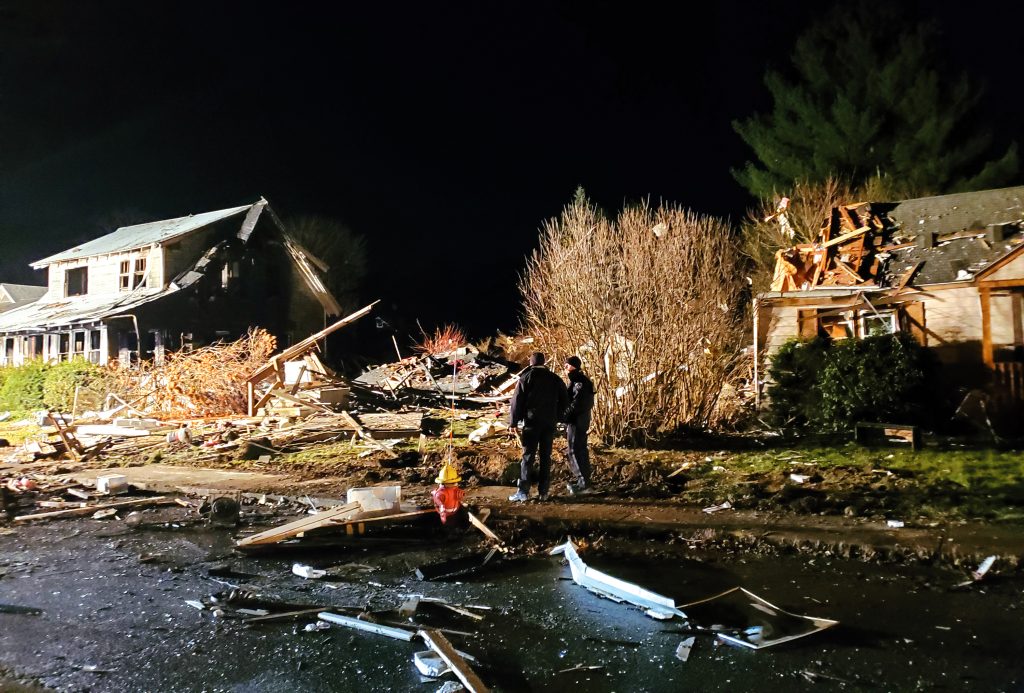
One mile away, at his home on County Highway 48, Town Supervisor Randal Mowers felt the shock.
“I thought my house had been hit by a truck,” Mowers said.
Arriving at the scene, Mowers saw the gravity of what had happened.
“People were going in every direction,” he said. “It turned our life upside down at Town Hall. We stayed there for two days.”
Mowers declared a state of emergency that night. The town hall remained open as a command center for two days to ensure access to Internet and phone service.
“Someone was present around the clock. Brooks’ [Barbecue] sent about 50 chicken dinners and coffee for the emergency crews. They didn’t charge a thing,” Mowers said.
Three extensions of the state of emergency were subsequently declared on December 14, 19 and 24.
Official Reports Given, Rumors Run Rampant
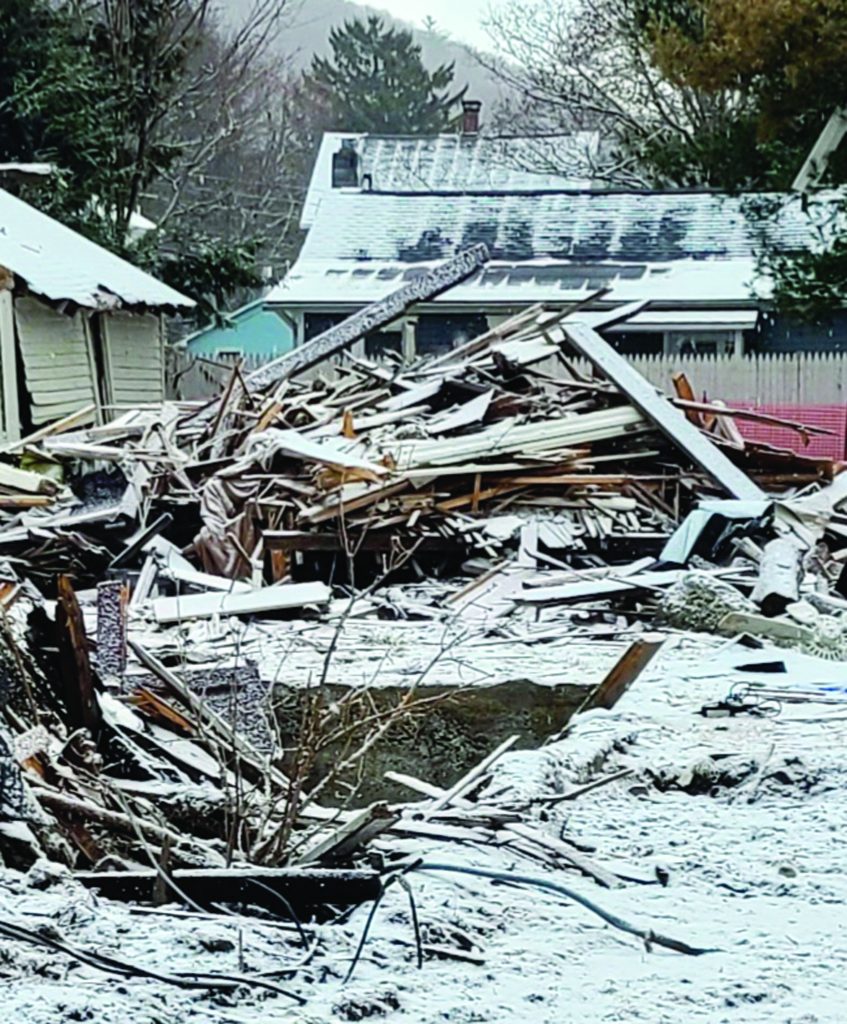
What caused the explosion? Everyone wanted to know. Rumors flew: Moan shot himself. He shot himself and the bullet hit a gas line. He shot at an intruder. He shot at an imagined intruder. He told his brother there was an intruder in the basement. The gas from the line filled the house and the furnace ignited it. There was a faulty gas line. The new gas line installed last summer was faulty. Rumors grew by the hour.
At least two neighbors find the idea of Moan’s suicide unthinkable. And no one heard a gunshot.
“He didn’t act like he had problems. Desi was socially adept, gregarious, kind, perfectly articulate and mild-mannered,” said Baird.
Someone had reported smelling gas to NYSEG about 7:30 that morning but nothing had been found. NYSEG inspectors had apparently visited the area throughout the day. One inspector was inside 14 Richards Avenue when Moan’s house blew up. Hit by debris from the explosion, he nonetheless began evacuating people from their homes.
Just after 3 p.m. on Sunday, December 10, via a media release, Otsego County Sheriff Richard Devlin announced that the state Office of Fire Prevention and Control, assisted by his own office, had determined the cause of the explosion was accidental, resulting from human error. At a public meeting held Monday, December 18, at the Town of Oneonta Town Hall, Otsego County Undersheriff Cameron Allison related the determination that Moan had discharged a firearm within the house, damaging a branch of the residential gas line, resulting in a gas leak. The ignition source was said to be the furnace in Moan’s basement.
Community Relief Services Mobilize
Following the blast, immediate relief to residents came from numerous sources, among them the Otsego County Department of Social Services, Otsego County Department of Mental Health’s Mobile Crisis Assessment Team, Salvation Army, American Red Cross and Catholic Charities.
Patricia Leonard, executive director of the Family Service Association in Oneonta, said she was called the morning after the disaster and immediately started making personal hygiene bags and offering clothing and gas cards donated by community members. She also created an application form to identify residents’ needs.
The Sixth Ward Athletic Club offered a free pasta and meatball lunch on December 12. Also on that date, Elm Park Methodist Church held a prayer vigil.
Marcia Hoag and Kelly Allmendinger of The Lord’s Table at St. James’ Episcopal Church organized a December 21 fundraiser, held at the American Legion, garnering just over $3,000.00.
The Friends of Christmas gave gift cards and monetary donations and offered a meal at First United Methodist Church on December 23.
“The community raised $20,000.00 in cash and gift cards,” Leonard said, adding that FSA continues to offer support and advocacy and is still accepting after-blast donations. Checks may be sent to 277 Chestnut Street, Oneonta, NY 13820. Payments may also be made through PayPal at www.FSAOneonta.org. All donations should be earmarked “Richards Avenue.”
Aftermath Prolongs Difficulties
More than four months later, uncertainty about the future dominates the lives of those displaced. Limbo has become their way of life. Residents are experiencing mental, physical and practical aftershocks. For one resident, the explosion led to a primary blast injury that resulted in a stroke.
“I didn’t have the trauma of the moment, but I have the trauma of the aftermath,” Castine said.
On April 4, Castine was at her home sorting through her possessions for the packout. The house’s interior looked as if a tornado had hit. “Stuff” was everywhere. Castine was affixing blue tape to items for “keep” and yellow for “discard.”
Almost everything in her boarder Richard Baird’s room had to go in the trash. Baird had no insurance and Castine’s did not cover his belongings.
“It’s traumatic to be here, to be in this space in this condition,” she said.
In spite of the trauma, Castine manages to keep a sense of humor.
“Before, I used to have dust bunnies. Now,” she said, “I have dust Buicks.”
Speaking of her post-explosion experience, Bailey said, “At first I thought just the front door had blown off, but walls, ceilings, food from the kitchen shelves, books…it was like a hurricane had hit. Everything was destroyed.”
Insurance Nightmares
Dealing with insurance companies, Bailey said, has been “a nightmare.”
“We won’t even be back in our house by Christmas [2024]. There are no local insurance people. Everything is done by phone. We have asbestos. No contractor can begin to work until the asbestos is removed. Contractors are booked out until the end of the year. Out of five contractors, two have returned calls. Nobody seems to know the process. I wish there were a guidebook,” she said.
Bailey said that her insurance does not want to cover the cost of asbestos removal.
“That takes away $40,000.00 from house money,” she said, money needed for rebuilding.
Castine echoed Bailey’s frustrations with insurance companies.
“Insurance is the worst part of the ordeal, besides being displaced. I don’t know how long this will go on. Months? Years?” she wondered.
Also like Bailey, Castine is faced with asbestos concerns. Her insurance will cover asbestos removal for damaged areas of the house only, she said. But she will not know if she can renovate the house until several costly steps have been taken.
“If there is asbestos, abatement will have to occur. After the asbestos is taken care of, I can contact contractors for estimates to remove drywall. After the drywall is removed, an engineer will assess for structural damage. Then I will know if I can rebuild,” she said.
A Place To Stay, For Now
Castine found the packout company assign-ed by her insurance company to be “pushy.” It offered neither climate-controlled storage nor access to the Matterport photos—360-degree photos that document contents and measure room dimensions. Without asking her permission, the company dropped a container pod on her property, and, she said, “harassed” her to schedule the packout when she had the flu.
Castine then hired a family-owned business in Otego, ServiceMaster by Burch.
“They have been fantastic. They took Matterport photos and submitted them, along with the estimate, to the insurance company for approval. They also made the photos accessible to me, so I can compile a list of my losses. They offer climate-controlled storage and have been diligently contacting the insurance company on my behalf,” Castine said.
Between December 9 and late March, having neither heat nor electricity at her house, Castine had been unable to work there. Her new company set up a generator for her. Still, she has been able to work there only four days. Much of the wrecked furniture and debris has now been cleared, though broken glass from the front window still lies on the sill or has been swept to the floor’s mopboard. When the front door was blown in, its metal lock was ripped out of the wood. A piece of wallboard has been removed to check a front stud, which has a long split from having flexed inward, indicating structural damage.
The engineer hired by Castine concluded that her house had been lifted from its foundation and dropped back down. The insurance company engineer, Castine said, did not think the foundation had been damaged.
Despite all these stresses, Castine has appreciated the generosity of the community. Besides acknowledging the community services described above, Castine said she was touched by an unknown neighbor’s donation of a $30.00 gift certificate to Undercover Eggplant, a nearby eatery—one of her favorites.
Castine found a new dwelling by posting on Facebook.
“A local family saw the post and offered me a small, one-bedroom apartment. They were so kind. There was no security deposit or pet fee. I was given the key immediately. It was such a relief,” she said.
Her insurance is paying for the rental apartment. She is still paying a mortgage on her home.
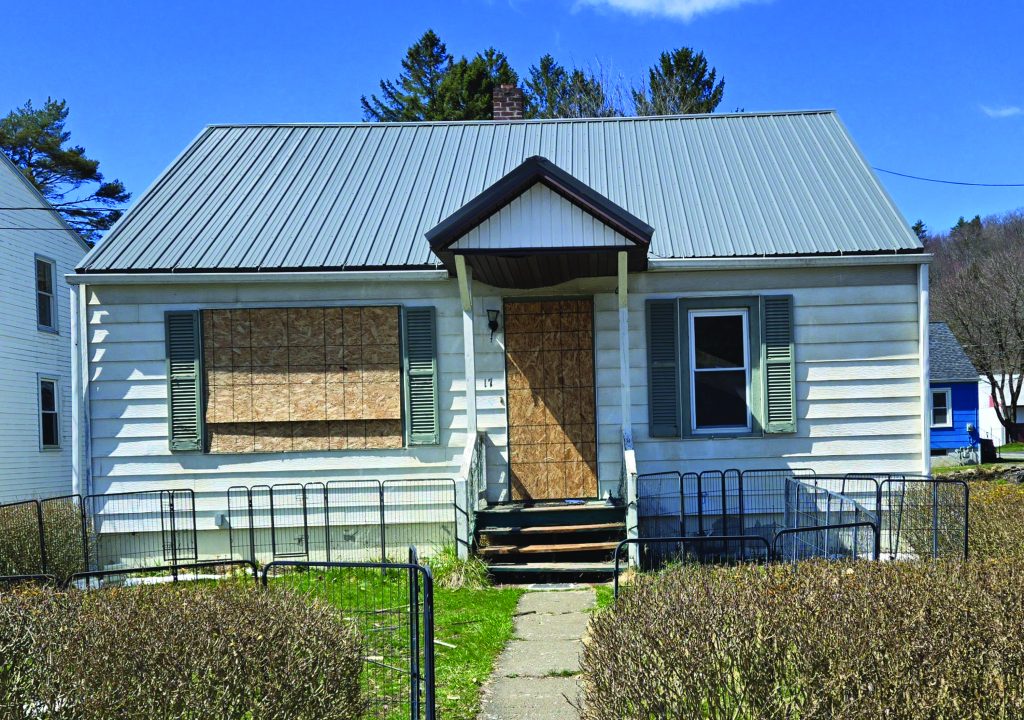
“Life has not been good since the explosion,” Baird said.
He currently has temporary housing but must be out by May. Affordable housing is hard to find, he said. He is on limited income and his family is helping him. He worked as a nurse for seven years, but he is now disabled and has an auto-immune disease. Since the blast, he has experienced tachycardia, or racing heart.
“I’m still dealing with symptoms [of trauma] on a daily basis. I don’t want to go out too much,” he said.
The Baileys and their grandson have temporary housing on Ceperley Avenue.
Bailey says she feels “blessed” to be staying at the home of Kathy Greenblatt.
“They said we could stay as long as we need to, but I get depressed and stressed just waiting and working with the insurance companies,” she said.
To compound the hardship of the gas explosion, Bailey’s daughter, Leia, Tyler’s mother, died on December 12.
“We lost our house and our daughter in three days’ time,” she said.
The explosion rocked more than the foundation of her house, “It shook my faith,” said Bailey, who, with her husband, was for 25 years a pastor at St. Matthews Church in Unadilla.
A Neighborhood Scattered
Richards Avenue is located in the normally tranquil section of Oneonta known as West End. People seek out housing there due to its solidly constructed single-family units—mostly built in the 1940s, according to realtor Jo Bordinger, who grew up in West End and described it as “an Ozzie and Harriet neighborhood.”
Castine agrees with that assessment.
“It’s a great neighborhood. People walking their dogs, kids on bikes. I know my neighbors—or did. It was a close-knit community. It’s sad so many people are not coming back.”
According to Leonard, 10 households have had to relocate. Three more houses, in addition to Doyle’s and Anderson’s, are to be razed. Other displaced residents must decide whether to return, have their home razed or consider reconstruction.
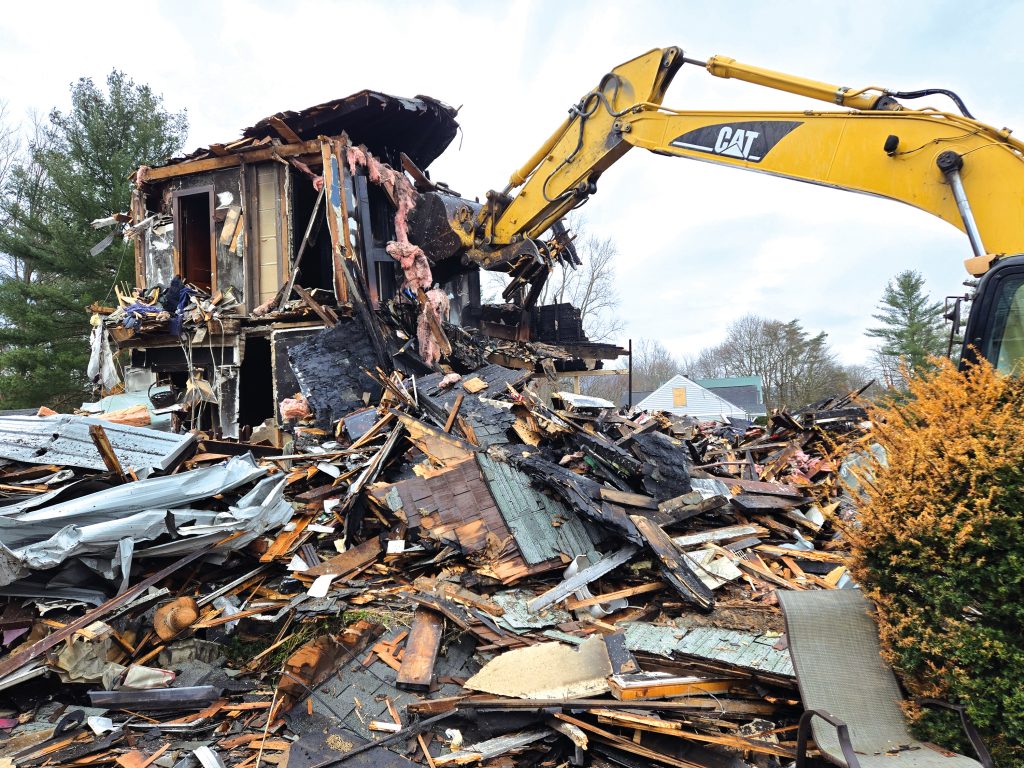
Clare Anderson, whose house was condemned and razed on March 27, does not plan to rebuild and is living with family in Saratoga Springs. Doyle also plans to live elsewhere. One couple has moved to another part of Oneonta and intends to sell their house “as is.” Phyllis Eggler, who was living at 19 Richards Avenue, is now at Saint James Manor, a retirement community in Oneonta.
And Desmond “Desi” Moan is gone forever.
Bailey is apprehensive about the future of the neighborhood.
“Who’s going to live on a street where there was a gas explosion? I wonder, do I want to look out on that [site of Moan’s leveled house]. It’s very sad. It was a wonderful neighborhood,” she said.


The question that no one seems to be asking is why did NYSEG not turn off the gas? That is the protocol when an area is permeated by the smell of gas. Turning off the gas means it doesn’t build up and easily explode. This is one of the reasons why we are told to call NYSEG when we smell gas. They were on site starting on Saturday morning the explosion happened at the end of the day. WHY DIDN’T THEY TURN OFF THE GAS?
People do seem to be asking that question. They just don’t have an answer.